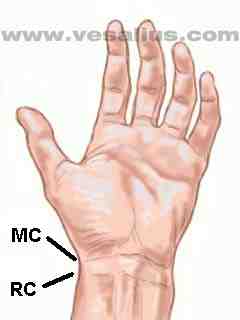Even though flexion and extension occur at both of the wrist's articulations,
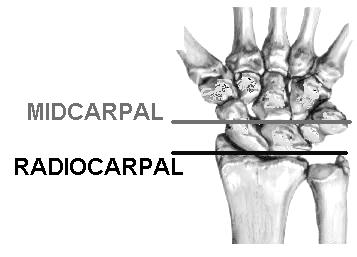
| most wrist extension occurs around the midcarpal joint's lateral axis.
most wrist flexion occurs around the radiocarpal joint's lateral axis.
|
|---|
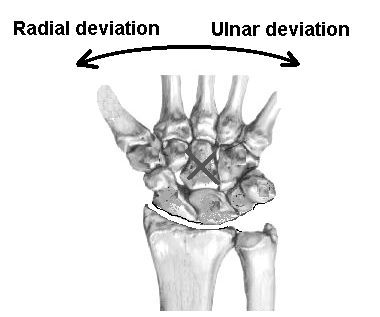
| Ulnar and radial deviation occur around an axis that passes through the capitate.
|
|---|
Two wrist creases on the hand's palmar (or volar) surface are landmarks for the locations of the radiocarpal and midcarpal joints.
Review: Bones of the wrist
from Charles Eaton MD, hand surgery pages.
Wrist arthrokinematics
In open chain movement, the convex surfaces of the scaphoid and lunate move on the concave surfaces of the radius and ulna.
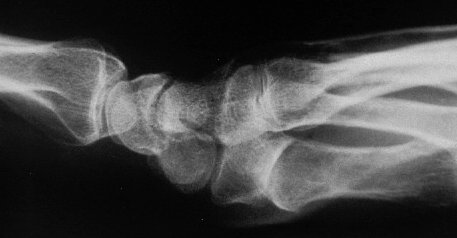
| during flexion:
scaphoid/lunate roll anteriorly (toward palm) and glide posteriorly(toward dorsum)
during extension:
scaphoid/lunate roll posteriorly(toward dorsum) and glide anteriorly(toward palm).
|
|---|
During ulnar deviation:
scaphoid/lunate roll toward ulna and glide toward radius.
During radial deviation:
scaphoid/lunate roll toward radius and glide toward ulna.
| 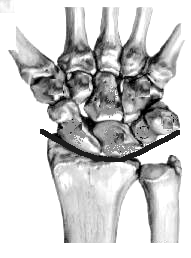
|
|---|
Muscles that move the wrist
To predict a muscle's action, you must know:
- the joint(s) that the muscle crosses
- the axis/axes of each of those joints
- the muscle's line of application (LOA) local to each of the axes.
- Extensors have LOA dorsal/posterior to wrist's lateral axis.
- Flexors have LOA ventral/anterior to wrist's lateral axis.
- Radial deviators have LOA on the radial side of the wrist's AP axis.
- Ulnar deviators have LOA on the ulnar side of the wrist's AP axis.
list of wrist and hand muscles
Examples of muscle synergies in wrist function
- palpate the ECRL as you make a fist or firmly grasp an object:
- role of the FDP:
the only muscle that flexes the DIP joints. Also flexes the PIP, MP, and wrist.
- role of the FDS:
flexes the MP and PIP joints; used for more forceful grasp
- role of wrist extensors (ECRB, ECRL, ECU):
maintain appropriate length and tension (force) in finger flexors so they can produce strong grip.
- Open your fingers forcefully and observe that the wrist flexes automatically.
- role of the extensor digitorum:
the only muscle that can open the fingers; also extends the wrist.
- role of the wrist flexors:
maintain appropriate length and tension in finger extensors they can forcefully open the hand
- Palpate the ECU as you quickly move the thumb away from the second digit. Why is the ECU active during this maneuver?
- apl/epb move thumb but also radially deviate wrist;
- ecu acts as true synergist.
- Carpal muscles act in helping synergies to produce:
- wrist flexion:
- wrist extension:
- ulnar deviation:
- radial deviation:
Carpal tunnel:
The "strut" that maintains the tunnel's shape is the flexor retinaculum, also called the transverse carpal ligament or the volar carpal ligament.
This ligament connects the scaphoid and trapezium on the hand's radial side with the hamate on the ulnar side.
| 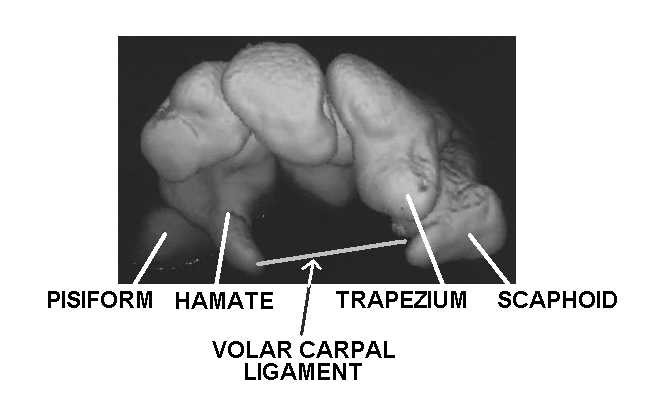
|
|---|
| The 3-D image is modified from Charles Eaton MD
|
|---|
The carpal tunnel contains (from radial to ulnar side):
- FCR tendon
- FPL tendon
- median nn.
- tendons of FDS and FDP
- also contains vascular structures
Repetitive motion can produce a tenosynovitis in the tendon sheaths of the long flexor
muscles. This, in turn, can increase hydrostatic pressure in the tunnel, causing compression damage to median nerve. "Carpal tunnel syndrome's" impairments include pain and paresthesia in the distribution of the median nerve. They also include weakness of muscles innervated by the median nerve, the thenar muscles, and the first and second lumbricales.
The tunnel's contents are also prone to compression injury due to trauma, congenital stenosis, acromegaly, or hormonal changes.
Last updated 12-6-02 ©Dave Thompson PT




